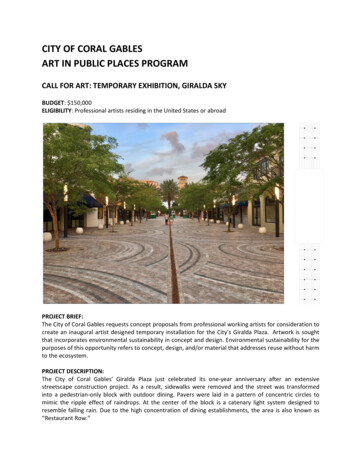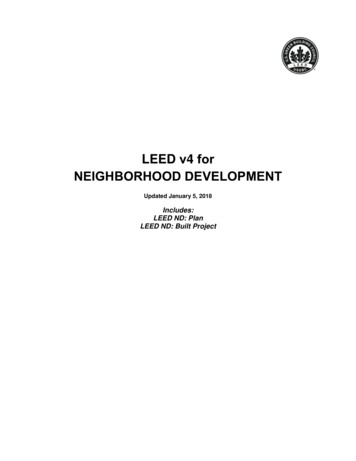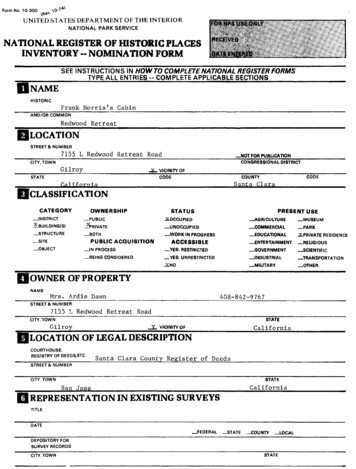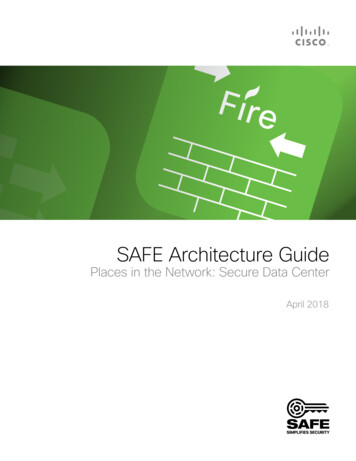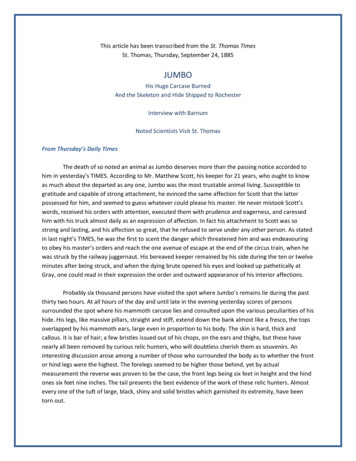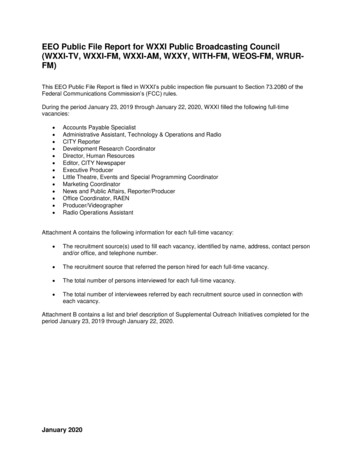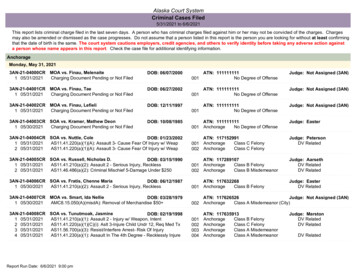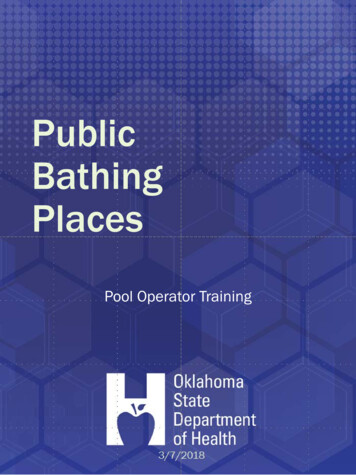
Transcription
PublicBathingPlacesPool Operator Training
OSDH Pool Operator CourseWhat’s new? New Presentation!Challenge Exam3-year certificateUpdating the Oklahoma Code within the next2 yearsv2018.03.07Why are we here? Learn Pool Operator Responsibilities To become familiar with the Oklahoma Rules& Regulations Learn from other’s Mistakes Instruct you how to do the job!Top 5 Violations - 2016Pool Operator Responsibilities1. Flow Meter/Flow Rate2. Total Alkalinity between 80 – 200 ppm3. Free Available Chlorine 1ppm; or Bromine 2ppm4. Decks, Gutter, Pool Finish: Clean, GoodRepair5. Records kept: Required testing done;Inspection posted The bathing place shall be maintained underthe supervision and direction of a properlytrained operator who shall be responsible forPromoting Good SanitationEnsuring Safety Perform required sampling & watermaintenance––––Chemical & operational parametersChemical analysis per regulationTurbidity prior to opening poolBalancing pool water Ensure animals are not allowed inside thepool enclosure– Promoting good Sanitation & Safety– Proper Maintenance of the bathing place and all Physical &Mechanical equipment– Recording KeepingO.A.C. 310:320-3-2(b) Enforce rules & regulations Exclude people under the influence of liquoror drugs Prevent tampering or playing with safetyequipment Conduct 2 unannouncedemergency drills annually– At least 1 involving a water rescueOklahoma1
OSDH Pool Operator Coursev2018.03.07Course OverviewMaintaining Equipment & Facilities Ensure gates/doors are locked when thebathing place is closed Ensure proper signs are placed Report to management any unsafeconditions or equipment which may bedetrimental to safe operation Ensure showers are used and operatingproperly Area around the Pool/SpaCirculation & DisinfectionRecords & Test KitsWater Chemistry & TestingBath HouseAccident & Incident ResponseClosing PoolsAdditional InformationFencing/Enclosure Outdoor Pools – such as Apartments, HOA,Hotel/MotelArea around the Pool/Spa–––––Pool Operator Training3/8/2018Must have a Self Closing/Self Latching GateMust be at least 4 ft tall;No more than a 4 inch gapDoes not Prevent Visual ObservationIs to prevent unattended small children from entering the pool9Fencing Outdoor Pools – such as City, YMCA, etc–––––Fencing must be 6 foot high woven wire fenceGates must be locked when not openBathers shall NOT have access unless a lifeguard is present.Does not Prevent Visual ObservationAre not required to have a SC/SL gateBarriers Indoor Pools– Must be located in a room with doors– The doors must be LOCKED when the pool is not in use– Regardless of whether a fee is charged So long as a lifeguard is present when the pool is openOklahoma2
OSDH Pool Operator Coursev2018.03.07Lifeguard RequirementsLifeguard Certification 1 or more shall be pool side when the pool isopen to the General Public and all pools withDiving boards/platforms higher than 1m Number of lifeguard on duty Must be at least 16 years old Current advanced life saving certificate mustbe displayed for each lifeguard Lifeguards– Shall provide reasonable general supervision of the activities in thewater– Enough to provide periodic rest periods– Recommended at least 1 lifeguard per 75 person Lifeguard assigned to the pool shall not besubject to duties that distract their attentionRequirements for No Lifeguard For Pools NOT open to the General Public asign stating -“No Lifeguard or Attendant on Duty” must be posted!––––Shall be capable swimmers and in good physical conditionsBe competent in life saving methodsBe able to perform artificial respirationShall be able to command respectSigns: Pool Rules 310:320-3-3 (a)– A cleansing shower, using warm water & soap, must be taken beforeentering the pool– Persons with open wounds, bandages, or any symptom ofcommunicable disease shall be prevented from entering the pool– Swimming alone is prohibited– Children under 12 years of age must be accompanied by an adultresponsible for that individual child at the pool side– Running & rough play are prohibited in and around the pool– “Cut-Off” should be hemmed– Excess body lotion should be removed prior to entering the water– Bathing load limitSigns: Pool Rules Animals are not allowed inside the poolenclosure– 310:320-3-2(d)(1)(J) No Food, Drinks, Debris or foreignsubstances are thrown or carried into thepool No glass containers of any type may be usedin or near the pool– 310:320-3-2(d)(2)(E)Oklahoma What is missing from this sign?3
OSDH Pool Operator CourseSigns: Spa Rules “Persons who are pregnant, takingmedication, or have any history ofcardiovascular disease should consult aphysician before entering hot water” “Drugs and alcohol are prohibited”Signs: Diving Utilize “No Diving” Signs when neededv2018.03.07Signs: Bathing Load The bathing load for the pool, wading pool orspa should be posted and enforcedLife Saving Equipment Small Pool ( 1600sq ft) Large Pool ( 1600sq ft)– 1 – 16ft straight polew/ a shepherd’s crook– 2 – ring buoys w/ ¼ in.rope– Some facilities mayneed to add extra Ringbuoys or Shepherd’sCrooks.Life Saving Equipment Lifeline– Located at or near the break in grade between the shallow & Deepportions of the pool– Marked with Colored floats spread on 5 foot centers– The line should be at least ¾ in rope.– It is required that a 6 inch black stripe be painted on the floor belowthe lifeline– MUST remain in pool during ALL operational hours Telephone– For use to reach emergency assistance without the use of coinageMUST be accessible to the pool during ALL hours of operation!Oklahoma– 2– 16ft straight pole w/a shepherd’s crook– 4 – ring buoys w/ ¼ in.rope– BackboardDecks Be constructed of concrete or otherimpervious material, have a slip-resistantfinish, be easily cleanable and not allowstanding water Should be kept clean and free of debris*– To clean the deck, scrub with a bleach and water solution (20 partswater to one part bleach) to prevent mold, mildew & bacteria. Should be in good repair– No major cracks or sections missing– No grass growing thru4
OSDH Pool Operator CoursePool Finishv2018.03.07* The finish should be smooth, non-absorbentand durable Pool Finish should be white or light in color Pool should be kept cleanDepth MarkersDepth Markers Are required to be at or above the watersurface on the pool wall and on the edge ofthe deck next to the pool At the maximum, the minimum and thebreaking point With a minimum of 3 markers per pool Numerals must be 4 inches in height Must be a contrasting color Replaced or repainted as neededStair Stripes Are required on all stairs/seats Markings shall be located on the top andfront facing part of the steps The stripes shall be at least 2 inches inwidth Must be of contrasting color Could be done with paint or tile Must be repaired or replaced as neededInlets In-wall or in-floor inlets return filtered,heated & chemically treated water to pool Inlets are important when directing thecirculation pattern in the pool– Looking for equal distribution of the returned water Replace when broken or missing– If the inlets are not in place, you may end up with “dead” spots.OklahomaMain Drains Collects water from the bottom of pool Install proper covers that meet theANSI/ASME A112.19.8-2007 standard(Virginia Graeme Baker) on every drain Refer to 310:315-7-14 (h) Outlets fordetailed information5
OSDH Pool Operator Coursev2018.03.07Main Drains Public Bathing Place Facility Standards– 310:315-7-14 (h) Outlets A Safety Vacuum Release System (ANSI A112.19.17 or ASTM StandardF2387) A suction-limiting vent system, must be tamper-resistant A gravity drainage system that utilizes a collector tank A automatic pump shut-off system A device or system that disables the drain An unblockable Suction outlets (ANSI A112.19.8-2007)Main Drains Must be marked by a 2 inch dark coloredstripe outlining the Main Drain Unless the Plate or Grating are a contrastingcolorMain Drains Would you consider either one of these to bein violation?Gutters Water level should bemaintained to ensure aconstant overflow into thegutter when bathers arenot present Should be kept clean andfree of clogs Maintained in good repairSurge or Balance Tanks Holds displaced water from pool overflowdue to active swimmers or overcrowdedconditions Helps Establish Hydraulic equilibrium Each swimmer will displace 20 gallons ofwater!*Skimmers Make sure you havea weir in place Double check yourbaskets Float valve forequalizer lines Check the equalizerline coverOklahoma6
OSDH Pool Operator Coursev2018.03.07Ladders, Handrails, & CopingDiving Boards Ladders must be properly installed Pools with diving facilities shall be designedIAW standards set by FINA, NCAA, or U.S.Diving, Inc. Diving boards and platforms exceeding 3min height should not open to general public Regularly inspect the bolts, treads and otherparts for corrosion. Replace as needed Keep the diving board tread free of debris If replacing, contact the Health Department– Most pools will have at least 1 ladder– Make sure the ladders are secured correctly– Make sure the bumpers are installed on the Ladder Handrails are necessary on stairs leadinginto the pool– Make sure the handrails are secured correctly Bullnose coping is recommended– It must be in good repair– Cannot extend more than 3 inches inside the pool wallBasic RecirculationCirculation & DisinfectionPool Operator Training3/8/201839Piping & Valves Piping shall always be labeled Each suction line should have a separatevalve Instructions for your facility should also beavailableOklahomaValves CONTROL the flow Required on each skimmer/gutter and maindrain line to adjust the flow between them Water flow from pool– 30% from main drain– 70% from skimmers and gutters7
OSDH Pool Operator Coursev2018.03.07Gate Valves Vertical disc or Larger pool systemswedge attached to along threaded stemBall Valves Typically usedon spas andsmall pools Handles tend tobreak moreeasily thanother types ofvalvesButterfly Valves Disc mounted on avertical or horizontalpivotMultiport Valves Turn off pool Several settings– Filter– Rinse– Backwash Setting selectsthe differentpipes to flushPumps Flow is measured in gallons per minute(GPM) and head pressure (resistance) isexpressed in pounds per square inch (PSI) Must be operational at all times and be theproper size for your system The hair & lint strainer basket will collectlarge debrisFilters Types of Filters––––Rapid Rate Sand (Sand & Gravel)High Rate SandDiatomaceous Earth (D.E.)Cartridge– It should be checked on a daily basis– You must have 2 baskets for each pump.Oklahoma8
OSDH Pool Operator CourseRapid Rate Sand Filters Multiple large tanksMultiple layers of sand and gravelVacuum or pressure systemsFiltering rate is 3 GPM per square footEach tank must be backwashed individuallyFlocculants may be added to pool waterv2018.03.07High Rate Sand Filters One large tank or multiple tanks– Vertical or horizontal Single layer of sand– Single layer of pea gravel to protect laterals Always a pressure system Filtering rate is 15 GPM per square foot– A compound usually used with sand-type filters to form a thin,gelatinous layer to help pull out & clump particles from the waterHigh Rate Sand Filters Must be backwashed collectivelyFlocculants are NOT recommendedFreeboard amount is 50% of sand depthMust be NSF approvedDiatomaceous Earth (D.E.) Filters Single tank with multiple screens/leaves/septums (grids) to hold filter media (D.E.)– D.E. coats screens/leaves to provide filtering D.E. must be precoated or slurry (body) fedonto grids Vacuum or pressure systems Filter rate is 2.5 GPM per ft2 of surface area May be backwashed or manually cleaned– Manually clean grids using TSP (trisodium phosphate) & water; allowto dry; dispose slurry as hazardous waste– Dispose waste water through adequately sized separation tank Must be NSF approvedCartridge Filters Single or multiple pleated elementscomposed of synthetic fibrous material(usually polyester) attached to cylindricalcore Normally used on pressure systems Filtering rate .375 GPM - 1.0 GPM per sq. ft.OklahomaCartridge Filters Must be manually cleaned– Clean with TSP (trisodium phosphate) and water– Use 10 to 1 diluted solution of muriatic acid to remove scale(Caution: If acid is used first, it will set oils) Two separate sets of cartridges Must be NSF approved9
OSDH Pool Operator CourseGauges & Meters Filter systems have 3 gauges:– Compound/Strainer gauge– Influent gauge– Effluent gauge Flow meters measure the speed the watermoves through the system– Measured in Gallons per Minute (GPM)v2018.03.07Compound Gauges Located on thepump Helps to identifywhether or not thehair and lint straineris clogged– or a possible problem frommain pipe to strainerInfluent Gauges Indicates pressureexerted by pump topush water throughfilter “In” flowing water The influentpressure gauge isusually located ontop of the filterSight Glasses Will help youdetermine when thefilter has beenproperlybackwashed Helps eliminatewasted waterOklahomaEffluent Gauges Located on pipingafter the filter Indicates pressureexerted by the pumpto push water backto the pool after itexits the filter “Out” flowing waterPool Volume & Flow Rate Must be posted inthe Equipment area Must be legible10
OSDH Pool Operator CourseFlow Metersv2018.03.07* Every public swimming pool filter systemmust have a Flow Meter Please install according to theManufacturer’s directions Is it working Are you meeting your turnover requirement?Chemical Feeders What Type of Feeder do you use?––––Erosion FeederPeristaltic or Diaphragm PumpGasElectrolysis Is your system automatic or do you have tocontrol it?– Pool ?– Spa ?– Wading pool ?Chemical Feeders Feeds the chemicals automatically– Erosion Chlorine or Bromine Feeders– Peristaltic and diaphragm pumps feed liquid chlorine and pHadjusting chemicals– Gas chlorinators are vacuum operated design using venturioperated injector– Must be NSF approvedpH Controls Feeders for pH adjustment must be providedon all pools using gaseous chlorine pH controls can be used on systems utilizingother types of feeders but that is notrequired Automation/Controllers - monitor sanitizerand pH and direct chemical feeders to addchemicals as required Electrolysis (salt)Salt Systems Electrical charge splits the sodium intochlorine and other chemicals– No or Low Salt NO CHLORINE– High Salt NO CHLORINE Must use salt specified by system mfr.– Manufacturer will set the high & low– Common settings: 1,800ppm (low) & 3,200 (high) Salt generators must have a water controlsystem ONLY reversing flow cells approvedOklahomaSalt Cells Salt generator contains a “cell” Cell lasts about 3 years Must be cleaned frequently (weekly)– Frequent cleaning extends cell life– Follow manufacturer’s directions High & low salt cutoffs NO CHLORINE– Lights will be green but no Cl2 Cell size must be appropriate to size of pool11
OSDH Pool Operator Coursev2018.03.07Salt SystemsSpas Spas will have a higher chemical demanddue to:––––High turnover rateHigher water Temperatures (105F max)Higher soil loadsHigh bather load Maintaining the chemical balance can bedifficultSpasEnforce rules & regs. through proper signsWater does not exceed 105ºFMain drain is secure & clearly visibleTest and keep records as per codeDrain the spa after heavy use (especially ifthe tub is 2,000 gallons or less). Therequired schedule for draining is two (2)times a month if the spa is sparsely used Drain the spa & clean it whenever in doubt Water Supplies Water for the Bath House, drinking fountainand the Public Pool must come from anApproved Source– The source must be approved by ODEQ– Must be approved prior to constructionHeated Facilities All indoor heated facilities are required tohave 3 thermometers!– 2 on the filter system– 1 handheld in the pool Ambient Air Temperature must bemaintained– A suitable thermometer must be deck sideWater Supplies Pool Wastewater– Must go to a Sanitary Sewer– Used for Pool Make up Water after sedimentation & Filtration– Water may be used for irrigation after sedimentation Backflow Prevention is a must! Hose bib connections must be provided– Utilizing a 50 foot hose– Must have an approved vacuum breaker at all hose connectionsOklahoma12
OSDH Pool Operator Coursev2018.03.07Vacuum BreakersBack Washing Backwash necessary when:– Pressure gauge indicates a pressure difference of 8-10 psi betweeneffluent and influent gauges– Flowrate is significantly reduced Valves for backwashing– Push-Pull valves– Multi-port valves Length of time to backwash:– Until water runs clear out waste line– About 2-3 minutesBackwash Water Is this allowed?Chemical Storage Store in original containers in a dry area Required to have on hand at least two-weeksupply of chemicals needed to maintain theproper chemical balance A sign stating “POOL CHEMICALS” shall beposted on the door leading into the chemicalstorage area Chemical storage should not be accessibleto the general publicWould you consider this safe?Records & Test KitsPool Operator Training3/8/2018Oklahoma7813
OSDH Pool Operator Coursev2018.03.07Daily Operational Form The DailyOperationalForm is nowavailableonline It can befound at .Operation Records* To be Completed DAILY Properly Trained PoolOperator or designeemust:Operation Records General Pool Info– Gallons– Flow Rate Min/Max– Bathing Load Equipment Checklist– Maintain record forms– Sign record forms– Backwash dates– Flow Readings Chemical Additions Test/Sample Results ObservationsOperation RecordsOklahoma*Test Kits Used multipletimes a day Instructionsclearly printedinside each kit(regardless ofbrand)14
OSDH Pool Operator CourseTest Kit Maintenance Store the test kit in a cool dark place Have the Color Standards checked once ayear to ensure accurate & reliable test Replace test chemicals as needed– When low– When the chemicals expire Some testing chemicals now have expiration dates on thebottlesv2018.03.07Taking Samples – Filling w/Water Conduct tests BEFORE adding chemicals Always rinse the sample container/testchamber with pool water (before & aftereach test) Fill test chamber(s) until bottom of watercurve is on the sample line level– Ensure test chamber isupright/level Follow instructions oninside of test kitTaking Samples - Location Must take multiple samples in differentplaces in poolTaking Samples – Adding Reagents When inserting drops, hold reagent bottlesstraight up & down (ensures uniform size)– No dead spots– Test shallow and deep ends Depth of sample is 12-18 inches Do not take samples in front of inlets unlesstesting the chlorinator The whole tank/pool must be in compliancewith sanitizer and pHTaking Samples – Adding Reagents Add test solution slowly, swirling or gentlyinverting after each drop. NEVER shake Read all test results immediately, unlessotherwise instructed After adding reagents to the vials, do NOTadd this water back to the pool– Dispose of in a gutter or separate containerOklahomaTaking Samples – Proper Handling Do not touch reagents, especially with dirtyhands Do not interchange reagent caps & droppers For “FAS DPD”, “TA”, & “CH” continue to add& count drops until color change completed Clean all testing equipment with pool waterafter completing all samples15
OSDH Pool Operator Coursev2018.03.07Reading Samples Use an outdoor light source or whitebackground (paper ideal) to read the colorWater Chemistry & TestingPool Operator Training3/8/201892Imminent HazardsTurbidity Turbidity: Main drain must be clearly visible FAC: must be 1.0 ppm; Bromine: must be 2.0ppm pH must be between 7.2-7.8 Main Drain must be secured Any other condition, act or omissionendangering health or safety You must be able to see the Main Drain or asix inch black disk on the bottom of thedeepest part of the pool from the sidewalk If water Turbidity is Too High:Types of ChlorineWater Contaminants Unstabilized Stabilized(No Cyanuric Acid)(Contains Cyanuric Acid)– Calcium Hypochlorite (granular) –65% available Chlorine pH 10.8 to 11.8– Sodium Hypochlorite (liquid) – 10to 15% Available Chlorine pH 13.0– Lithium Hypochlorite (Granular)– 35% Available Chlorine pH 10.7– Gas – 100% available Chlorine pH 1.0Oklahoma– Sodium Dichlor – 55%available Chlorine pH 6.8 – 7.0– Trichlor – 90% availableChlorine– Chlorine level may be too low– Filtration system may be inoperative– Too turbid water may lead to drowning due to reduced visibility. Sanitation– The process of destroying organisms that are harmful to people Oxidation– The process of chemically removing organic debris from the water Algaecides– Algaecides control the growth of algae in pool or spa water pH 2.8 – 3.0Chlorine sanitizes, oxidizes and controls algae growth.16
OSDH Pool Operator CourseFree Available Chlorine A sanitizer must be continually activev2018.03.07*– Minimum: 1.0 ppm– Ideal: 1.0 – 3.0 ppm The chlorine residual is what ensures thesanitation of your water When any type of chlorine is added to water,it forms hypochlorous acid (HOCl) andhypochlorite ions (Ocl)– Together these two compounds are Free Available Chlorine (FAC)Combined Available Chlorine Chlorine in a pool or spa can become “Tiedup” with contaminants forming CombinedAvailable Chlorine (CAC or chloramines) Chloramines can:––––Cause Body, Eye and Skin IrritantsBe Foul smellingCause algal growthCause bacteria growth Chloramines are a weak disinfectant (40 –60 times less effective than FAC) We can measure FAC, TAC and CAC with a DPD test kit!Superchlorination Process of eliminating CAC from water byadding a large dose of chlorine to reach“chlorine breakpoint” Breakpoint chlorination – point in a risingchlorine residual at which the concentrationof available chlorine becomes great enoughto completely oxidize ALL organic matter andammonia compound in a poolCalculating Superchlorination Use the DPD Test Kit to test FAC and TAC tocome up with the amount of chlorinerequired– TAC – FAC CAC– Multiply CAC x 10– Total equals ppm of chlorine which must be added to reachbreakpoint– Weak disinfectant (40-60 times less effective than FAC)Note: This test shall be done while the pool is NOTSupplemental Treatments Potassium monopersulfate – non-chlorineshock Sodium chloride – electrolysis of salt Ozone – strong oxidizer and disinfectantgenerated onsite by UV light or elect. sparks Ionizer – use copper as algistat and/or silverbacteriostatBromine Has a pH of 4.0 to 4.5 Operating range is 2.0 – 4.0 ppm Bromine, like chlorine, combines withinorganic impurities to form combinedbromines or bromamines*– HOWEVER, combined bromine is still a semi effective sanitizer anddoes not smell– Because of this, bromine is popular for spasAll supplemental treatments have advantages anddisadvantages. In all cases, still required to maintain a chlorineresidual in addition to the supplemental treatment.Oklahoma17
OSDH Pool Operator Coursev2018.03.07pHpH pH is a value that determines how acidic(corrosive) or basic a solution is. pH is atemporary condition7.0Neutral0Acidic14BasicImportance of pH Vessel & equipment protection Swimmer comfort Sanitizer effectivenessImportance of pH Low pH––––––pH Ranges– Acceptable– Ideal 7.2 to 7.8 ppm 7.4 to 7.6 ppm Adjusting pH– To Raise:– To Lower:Use Soda Ash (sodium carbonate)Use Muriatic Acid (liquid) orDry Acid (sodium bisulfateAlways test and adjust total alkalinity beforetesting and adjusting pH.Oklahoma High pHEtched plasterCorroded metalsStained plasterEye & skin irritationDestruction of total alkalinityChlorine unstable–––––Scale formationCloudy waterShort filter runsEye & skin irritationPoor chlorine efficiencyTotal Alkalinity* Measure of resistance to change of pH(buffering capacity of the water). The correcttotal alkalinity helps maintain pHLow Total AlkalinityooooooEtched plasterCorroded metalsStained plasterEye and skin irritationDestruction of total alkalinityChlorine unstableoooooHigh Total AlkalinitypH hard to changeScale formationPoor chlorine efficiencyEye and skin irritationCloudy water18
OSDH Pool Operator CourseTotal Alkalinity Ranges (based on type of sanitizer used):v2018.03.07*– Acceptable 80 ppm to 200 ppm 80-100 ppm: sodium hypochlorite,calcium hypochlorite,or lithium hypochlorite 100-120 ppm: gas, dichlor, trichlor, or bromineCalcium Hardness Measures the Calcium and Magnesiumdissolved in water Adjusting Levels– To Raise: use sodium bicarbonate– To Lower: use muriatic acid (liquid) or dry acid (sodium bisulfate)Calcium Hardness Ranges– Acceptable 50-500 ppm Ideal – 200 to 400 ppm Maximum 500 ppm Adjusting Levels– To Raise: use calcium chloride (least soluble chemical)– To Lower: partially or completely drain pool and refill; spas shouldbe completely drained and refilledWater Balance If pH, Total Alkalinity and calcium hardnessare within recommended ranges, AND the water is correctly saturated withcalcium carbonate, THEN there is no tendency to corrode orscale.Note: Do NOT add calcium chloride the same day as sodaash or sodium bicarbonate as the water may turn cloudy.Testing Your Knowledge:WaterGram BalanceWater Gram Balance Wheel Must determine using the test kit:– pH– Total Alkalinity– Calcium Hardness Set the Total Alkalinity opposite the CalciumHardness on the Wheel Hold Calcium Hardness against TotalAlkalinity & set arrow to pH in window Read Saturation index opposite WaterTemperatureOklahomaProblem 1pHTotal Alk.Cal. HardnessTemperatureProblem 28.015050080ºFpHTotal Alk.Cal. HardnessTemperatureProblem 37.410020080ºFpHTotal Alk.Cal. HardnessTemperatureBalanced:Balanced:Balanced:Over Saturated:Over Saturated:Over Saturated:Under Saturated:Under Saturated:Under Saturated:7.2509080ºF19
OSDH Pool Operator Coursev2018.03.07Testing Your Knowledge:WaterGram BalanceOver SaturatedBalancedpH8.0Total Alk150Cal. Hardness 500Temperature76 FpH7.4Total Alk100Cal. Hardness 200Temperature76 FpH7.2Total Alk50Cal. Hardness90Temperature76 FSI SI -0.2SI -1.1 0.9Under SaturatedCyanuric Acid (Stabilizer) Sunlight destroys/degrades chlorine rapidly(90% of residual in 2-3 hours) Cyanuric acid acts as sunscreen and cutsout up to 90% of burn-off Ranges:– Minimum 30 ppm– Full range 30 – 50 ppm (w/ a ORP/pH controller)– Ideal 30 – 50 ppmCyanuric Acid (Stabilizer)Cyanuric Acid Not used for indoor pools/spas orpools/spas using bromine As cyanuric acid levels increase, ORP levelsdecreaseTotal Dissolved Solids Range– Acceptable 300 - 1,500 ppm Adjusting Level– To Lower: partially or completely drain and refill pool A high TDS can result in––––––OklahomaSalty-tasting waterColored but Clean waterAlgae despite a good sanitation levelCloudy WaterCorrosion of Metal PartsFalse Test ReadingsHeavy Metals Copper– Ideal: None– High: 0.3 ppm Too High–––––StainingWater may discolorChlorine dissipates rapidlyFiltering issuesMay indicate pH too low Iron– Ideal 0.2 ppm– Range 0.2 - 0.3 ppm Too High––––StainingWater may discolorChlorine dissipates rapidlyFiltering issues20
OSDH Pool Operator Coursev2018.03.07Heated Facilities Spa– Minimum: 90 F– Maximum: 105 F Indoor Swimming Pools– Minimum: 75 F– Maximum: 90 F Indoor Pool Air Temperature– Water Temperature 8 F Maximum– Water Temperature -2 F Minimum Taylor Test Kit – only accurate to 20-25 ppmFAC/Total Br DPD and TA test can be bleached by highsanitizer levels DPD is added pink clear, the reading ishigh Paper test strips– However, not reliable– Designed for personal (backyard) poolsInterference w/testsHigh Sanitizer Levels pH using PhenolRed – the indicatorused in the pH testYellow 6.8 pHRed 8.3 pHPurple – too highBromine gives a “false high”pH, use a meter– High Cl/Br reading canbleach Phenol Red giving afalse low pHInterference w/testsHigh Sanitizer Levels & MetalsInterference w/testsHigh Sanitizer Levels Total Alkalinity Test High sanitizer levels– Green Pink––––– Teal Yellow Taylor’s Test Kit – pH TestLef t Block pH 7.5 (peach color)Right Block high pH (purple color)Interference w/testsHigh Metal levels Calcium Hardnesstest– Pink Slate Blue (endpoint)Oklahoma Metals will interferew/ CalciumHardness test– Doesn’t turn slate blueOrder of Application Chemicals or sanitizers for water balanceadjustments should be added in thefollowing sequence:a)Free available chlorine (FAC)b)Total alkalinityc)pHd)Calcium Hardnesse)Cyanuric Acid (outdoor pools only)21
OSDH Pool Operator Coursev2018.03.07Order of ApplicationChemical Standards Adding Chemicals:ChemicalMinimumIdealMaximum1.0 ppm1.0 - 3.0 ppm5.0 ppma)Add large amounts gradually in thirds over a two-hour periodFree Chlorine(FAC)b)Add directly into the pool or spa when no swimmers are presentand time is sufficient to permit even distribution of thechemicalsCombined CL(CAC)NoneNone0.2 ppmBromine2.0 ppm3.0 ppm4.0 ppmc)Add granular chlorine or soda ash solution directly to the pool,but separately. Always mix chemicals into plastic containersthat have been filled with water firstPH7.2Total Alkalinity80 ppm80 - 100 ppmGas, dichlor, trichlor andbromine compounds100 - 120 ppm50 ppm125 ppmMinimum300 ppmAmount of Chlorine Compound to Introduce 1 ppm ChlorineIdealMaximum1500 ppmIron & Copper(Heavy Metals)NoneNone0.3 ppmStabilizer(Cyanuric Acid)30 ppm30 - 50 ppm100 ppmHot Water Fac.Temperature90ºFSwimming PoolsIndoor Pool-AirTemp (-Hot Water Fac.)105ºF75ºF90ºFWater Temp-2ºFWater Temp 8ºFMust be able to clearly seemain drain from pool sidewalk.Turbidity500 ppmTable AChemical StandardsTDS7.8200 PPMCalcium hypochlorite and lithiumhypochloriteCal. HardnessChemical7.4 - 7.680 - 120 ppm(Depends on type of sanitizer)Table BVolume of 02 fl oz2.56 fl oz12.8 fl oz1.60 pts1.60 qts1.00 gal2.00 gal1
Lifeguard Certification For Pools NOT open to the General Public a sign stating - “No Lifeguard or Attendant on Duty” must be posted! Requirements for No Lifeguard 310:320-3-3 (a) – A cleansing shower, using warm water & soap, must be taken before entering the poo
